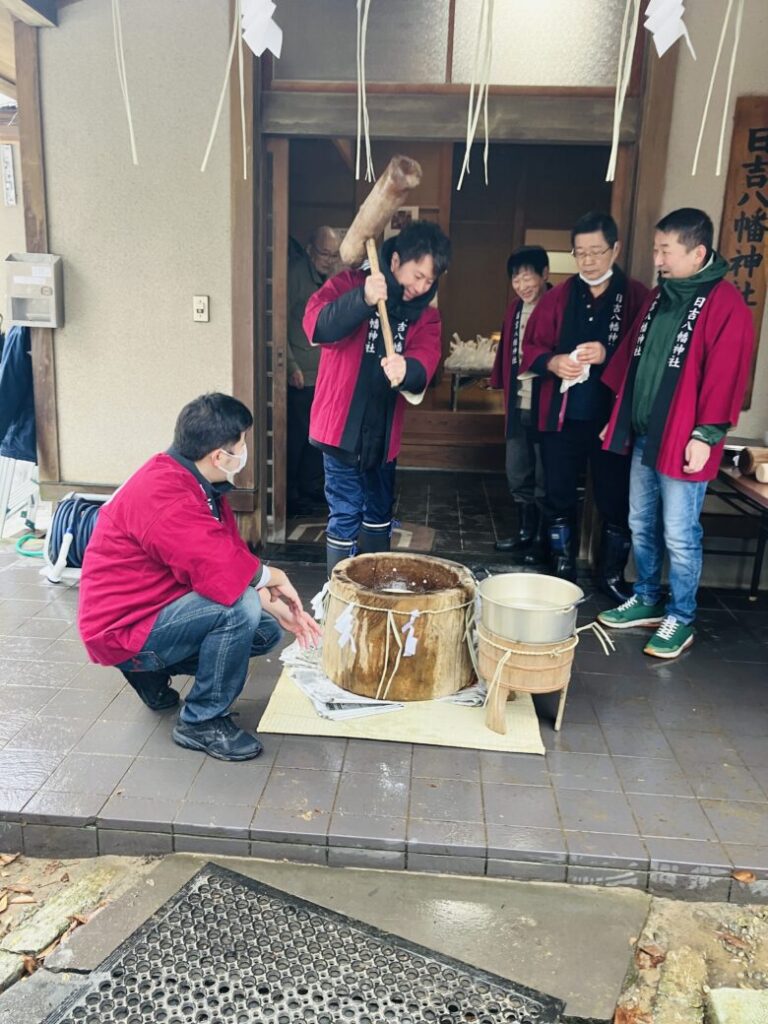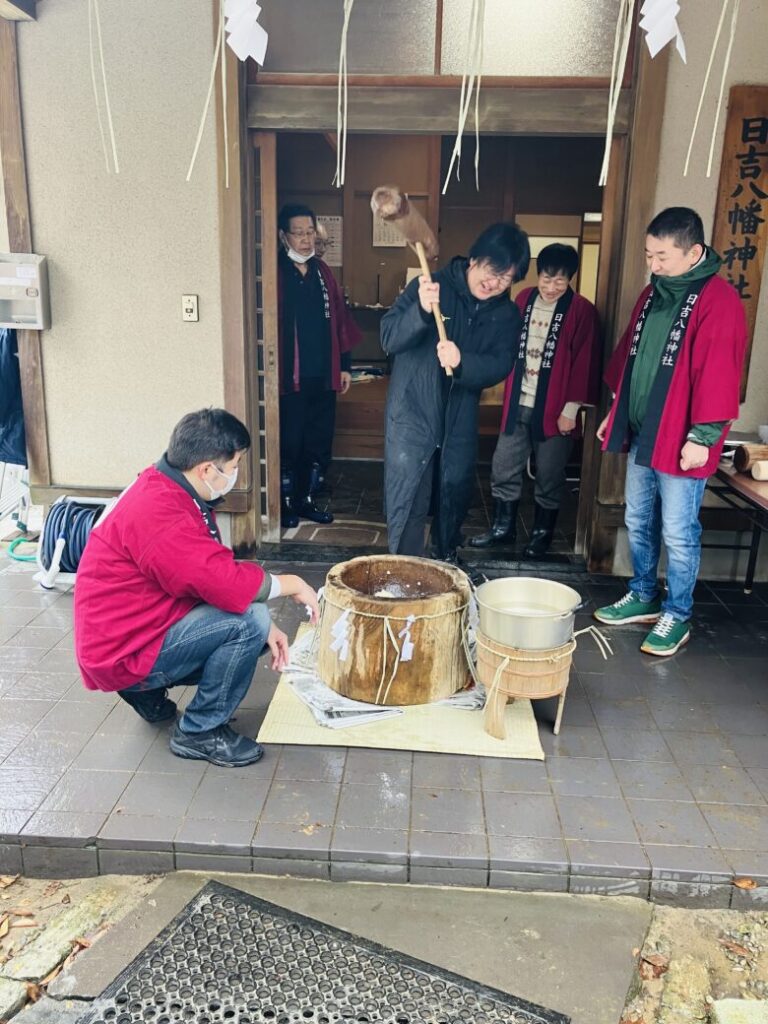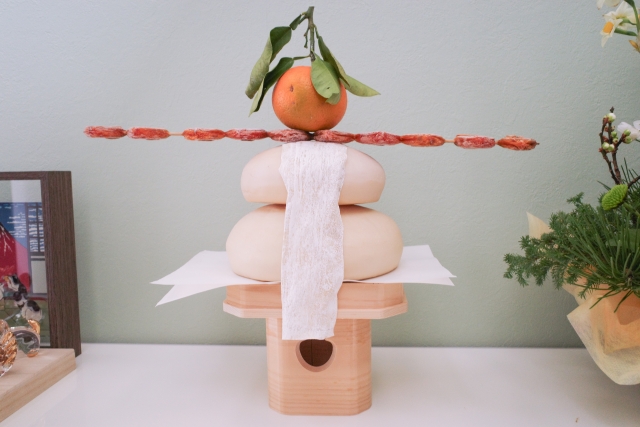年末に、日吉八幡神社から神様にお供えするお餅をつく行事があるので参加しませんか、とお誘い頂きましたので参加してきました。なぜお正月にお餅をつくのか調べてみたところ、この餅つきには「子孫繁栄」「一族の繁栄」を願う意味があるそうです。餅つきには臼と杵が欠かせませんが、それぞれ女性・男性を意味していることが由来なんだとか。
松の内、といって、年神様がおかえりになる12月28日ころから1月7日までの期間に餅をつきます。ついた餅は丸くしてお供えするため、その形状から鏡餅と呼ばれます。鏡餅は、年神様と呼ばれる穀物の神様にお供え物であり、拠り所でもあるとされています。
※神道では、「年神様」は、新しい一年の福徳を持って年始にいらっしゃる神様のことを指します。神道は、日本人の暮らしの中から生まれた信仰であり、神道の神々は、海の神、山の神、風の神のような自然物や自然現象を司る神々、衣食住や生業を司る神々、国土開拓の神々などで、その数の多さから八百万の神々といわれるほど数多く多様なのが特徴です。
鏡餅は、丸い大小のお餅を重ねてお供えしますが、大小の2つのお餅を重ねることで、月(陰)と日(陽)を表しているとも言われているようです。幸福と財産(福徳)が重なって縁起がよいと考えられているほか、円満に歳を重ねるという意味も込められているのです。




【English】
I participated in the year-end Mochitsuki event at the Hie Hachiman Shrine.
At the end of the year, I was invited to join an event where mochi (rice cakes) would be made and offered to the gods at Hie Hachiman Shrine. When I looked into why mochi is made during this time, I found that mochitsuki symbolizes the wish for “prosperity of descendants” and “family prosperity.” Mochitsuki requires a mortar and pestle, each symbolizing female and male, respectively.
During the period called “Matsunouchi,” which starts around December 28 when the New Year’s deity returns, mochi is pounded. The mochi made during this time is shaped into round forms and offered, leading to its name “kagamimochi” (mirror mochi). Kagamimochi is an offering to the deity of grains called “Toshigami-sama” and is considered a focal point.
In Shinto, “Toshigami-sama” refers to the deity who comes to bring blessings for the new year. Shinto is a belief system that emerged from Japanese daily life, and its gods govern natural elements such as sea, mountain, and wind, as well as aspects of human life like clothing, food, shelter, and livelihood. Shinto is characterized by its diversity, with a multitude of gods, said to number eight million.
Kagamimochi involves layering round rice cakes of different sizes, and this act is thought to represent the moon and the sun. It is believed to bring good luck when happiness and wealth (blessings) are stacked together. Additionally, it is considered a symbol of aging gracefully.
【Español】
Participé en el evento de Mochitsuki de fin de año en el Santuario Hie Hachiman.
A finales de año, me invitaron a unirme a un evento en el que se hacían mochis (pasteles de arroz) y se ofrecían a los dioses en el Santuario Hie Hachiman. Cuando investigué por qué se hacen mochis durante este tiempo, descubrí que mochitsuki simboliza el deseo de “prosperidad de los descendientes” y “prosperidad familiar”. Mochitsuki requiere un mortero y una maja, cada uno simbolizando a la mujer y al hombre, respectivamente.
Durante el período llamado “Matsunouchi”, que comienza alrededor del 28 de diciembre cuando la deidad del Año Nuevo regresa, se golpea el mochi. El mochi hecho durante este tiempo tiene forma redonda y se ofrece, lo que lleva a su nombre “kagamimochi” (mochi de espejo). Kagamimochi es una ofrenda al dios de los granos llamado “Toshigami-sama” y se considera un punto focal.
En Shinto, “Toshigami-sama” se refiere a la deidad que viene a traer bendiciones para el nuevo año. El Shinto es un sistema de creencias que surgió de la vida cotidiana japonesa, y sus dioses gobiernan elementos naturales como el mar, la montaña y el viento, así como aspectos de la vida humana como la vestimenta, la comida, el refugio y el sustento. El Shinto se caracteriza por su diversidad, con una multitud de dioses, se dice que suman ocho millones.
Kagamimochi implica apilar pasteles redondos de diferentes tamaños, y se cree que esta acción representa la luna y el sol. Se cree que trae buena suerte cuando la felicidad y la riqueza (bendiciones) se apilan juntas. Además, se considera un símbolo de envejecer con gracia.

